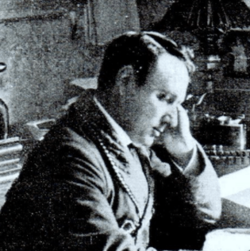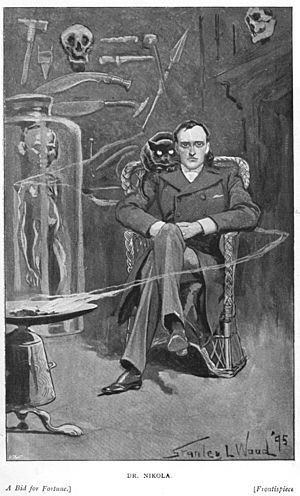Guy Boothby facts for kids
Quick facts for kids
Guy Boothby
|
|
|---|---|

Guy Boothy in 1896
|
|
| Born | October 13, 1867 Adelaide, Colony of South Australia |
| Died | February 26, 1905 (aged 37) Boscombe, United Kingdom |
| Resting place | Wimborne Road Cemetery, Boscombe |
| Occupation | Colonial administrator Author |
| Genre | Ghost stories Adventure Travel |
| Notable works | Dr Nikola series |
| Relatives | T. Wilde Boothby (father) Benjamin Boothby (grandfather) William Boothby (uncle) |
Guy Newell Boothby (born October 13, 1867 – died February 26, 1905) was a very busy Australian writer. He wrote many exciting adventure stories and mysteries. His books were popular in magazines around the late 1800s.
He lived mostly in England. Guy Boothby is best known for his Dr Nikola series. These books are about a clever, mysterious criminal mastermind. He also wrote Pharos, the Egyptian, a spooky story about mummies and ancient curses. Famous writer Rudyard Kipling was his friend.
Contents
About Guy Boothby's Life
Guy Boothby was born in Adelaide, Australia. His family was well-known in the new British colony of South Australia. His father, Thomas Wilde Boothby, was a member of the local government. Several of his uncles were important leaders in the colony. His grandfather was a judge.
When Guy was about seven, his mother moved back to England with her children. Guy went to good schools there. He studied at Salisbury, Lord Weymouth's Grammar, and Christ's Hospital in London.
Returning to Australia
At 16, Guy Boothby went back to South Australia by himself. He started working for the local government. He became the private secretary to the mayor of Adelaide. But Guy didn't really like this kind of work.
Even though his family worked in government, Guy preferred creative things. He wanted to write and create. In 1890, when he was 23, he wrote the words for an opera called Sylvia. He also wrote another show, The Jonquil, in 1891. He even acted in an operetta called Dimple's Lovers. The music for these shows was written by Cecil James Sharp.
Guy wanted his plays to be a big hit, but they didn't get much attention in Adelaide. In the early 1890s, Australia faced money problems. So, in December 1891, Guy decided to move to London to try his luck there.
Adventures on the Way to London
Guy's first trip to London didn't go as planned. He ran out of money and had to get off the ship in Colombo, Sri Lanka. He then had to find his way home through South East Asia.
It's said that he took many different jobs to survive. He worked on ships, in mines, and even as a diver looking for pearls. He traveled through many places like Singapore and Thursday Island. He also crossed Australia overland to get back to Adelaide.
These travels gave Guy many exciting stories and experiences. These adventures later inspired many of his books.
Becoming a Famous Writer
About two years later, Guy finally made it to London. In 1894, he published a book about his travels called On the Wallaby, or Through the East and Across Australia. This book was quite successful.
Later that year, his first novel, In Strange Company, came out. It was an adventure story set in England, Australia, and other exotic places. This book showed what Guy Boothby's writing would be like. He often used exciting, far-off locations in his stories.
By 1895, Guy had written three more novels. One of them was A Bid for Fortune, which was the first Dr Nikola book. This book made him very famous. He wrote incredibly fast, sometimes six novels a year! In total, he wrote over 53 novels and many short stories and plays.
Guy Boothby's Passing
Guy Boothby died at his home in Boscombe, near Bournemouth, England. He was 38 years old. He passed away on February 26, 1905, due to problems from the flu. His grave is in the Wimborne Road Cemetery in the town.
Guy Boothby's Writing Style
At first, some of Guy Boothby's stories were about life in Australia. But later, he started writing different types of fiction. These included crime stories, adventure tales, science fiction, and spooky Gothic horror.
His books often featured interesting and powerful villains. These bad guys were usually more exciting than the main heroes. They included classic supernatural monsters, strange deformed characters, and smart international criminals. These villains were like early versions of the bad guys in Ian Fleming's James Bond books.
Guy Boothby's novels helped create two popular ideas in movies. These were the clever international criminal and the revenge of ancient Egyptian mummies. These ideas are still popular today.
The Dr Nikola Series
Guy Boothby was once very famous for his books about Doctor Nikola. Nikola was a mysterious character who wanted to live forever and rule the world. His adventures began with A Bid for Fortune. This story was published in The Windsor Magazine.
Dr Nikola is described as a slender man with dark, unusual eyes and dark hair. He wears perfect evening clothes. He lives in a bungalow in Shanghai. Pictures of Dr Nikola often show him with his black cat, Apollyon. This huge, gleaming-eyed cat is always perched on Nikola's shoulder. Nikola is very smart and cultured, but he doesn't care about rules. Everyone fears him.
One writer, John Clute, said that the main goal of the series is Nikola's search for a special Tibetan method. This method would bring the dead back to life and make living people immortal. Nikola is very smart and has special powers. He might even have reached his goal.
A play about Dr Nikola, called The Adventures of Dr. Nikola, was performed in London in 1902.
Other Exciting Novels
In his book A Prince of Swindlers, Guy Boothby created a character named Simon Carne. Carne was a gentleman thief, much like the famous character Raffles. Simon Carne also had a secret identity as a detective named Klimo. Carne first appeared in Pearson's Magazine in 1897, even before Raffles.
Pharos the Egyptian (1899) is a thrilling story with romance and some supernatural elements. In this book, a very creepy old man named Pharos turns out to be Ptahmes. Ptahmes is a mummy who has survived for centuries. He still has all his magical powers.
The Curse of the Snake (1902) is considered one of Boothby's most interesting novels. It starts with a wonderfully spooky beginning. However, some say the ending doesn't fully explain the mysteries.
Spooky Ghost Stories
Guy Boothby also wrote many ghost stories. Most of these can be found in his collections Uncle Joe's Legacy and Other Stories (1902) and The Lady on the Island (1904). Some of his well-known ghost stories include "The Black Lady of Brin Tor" and "A Strange Goldfield." Others are "The Lady on the Island" and "Remorseless Vengeance." These stories have been printed again in many horror collections.


